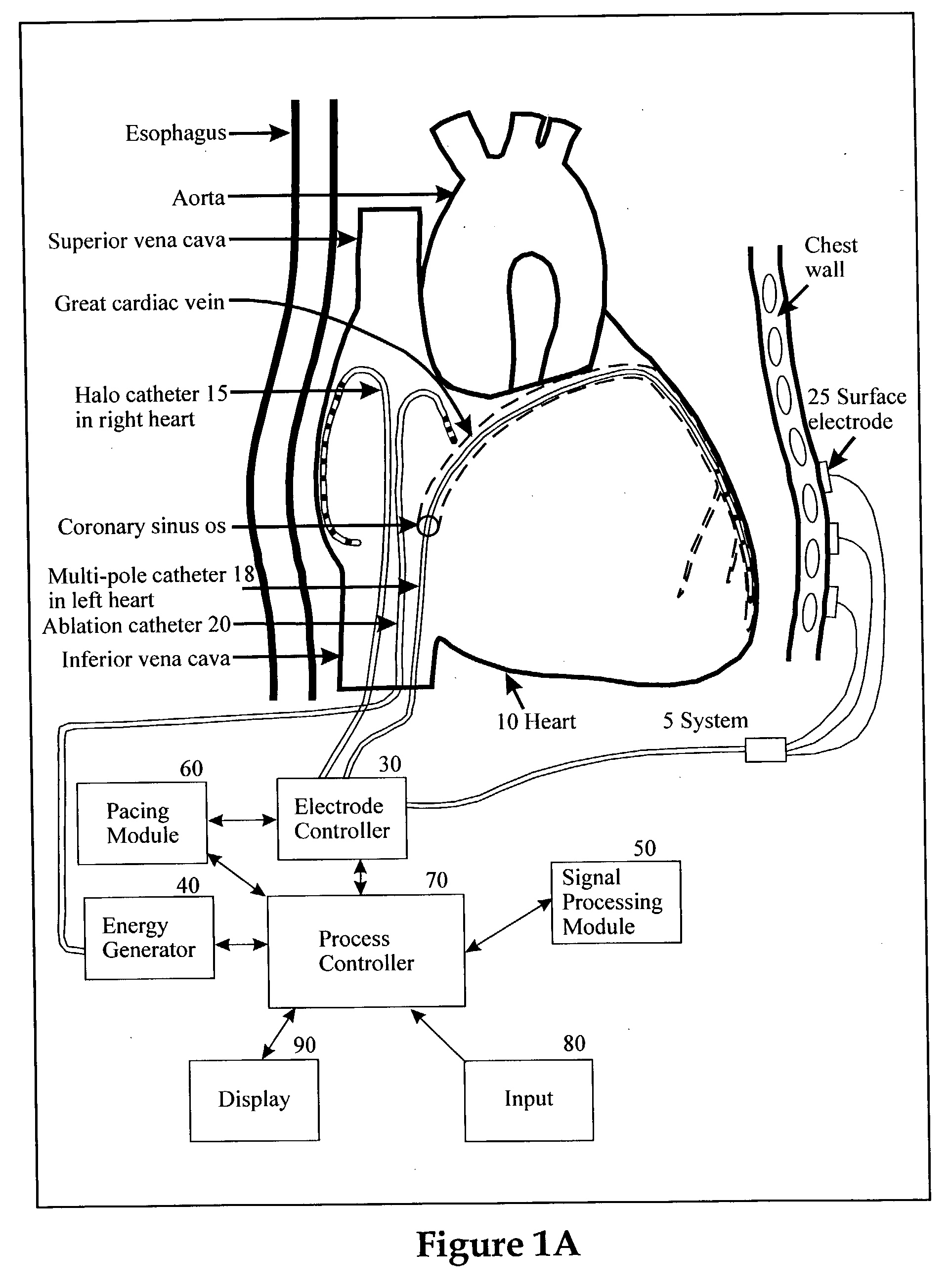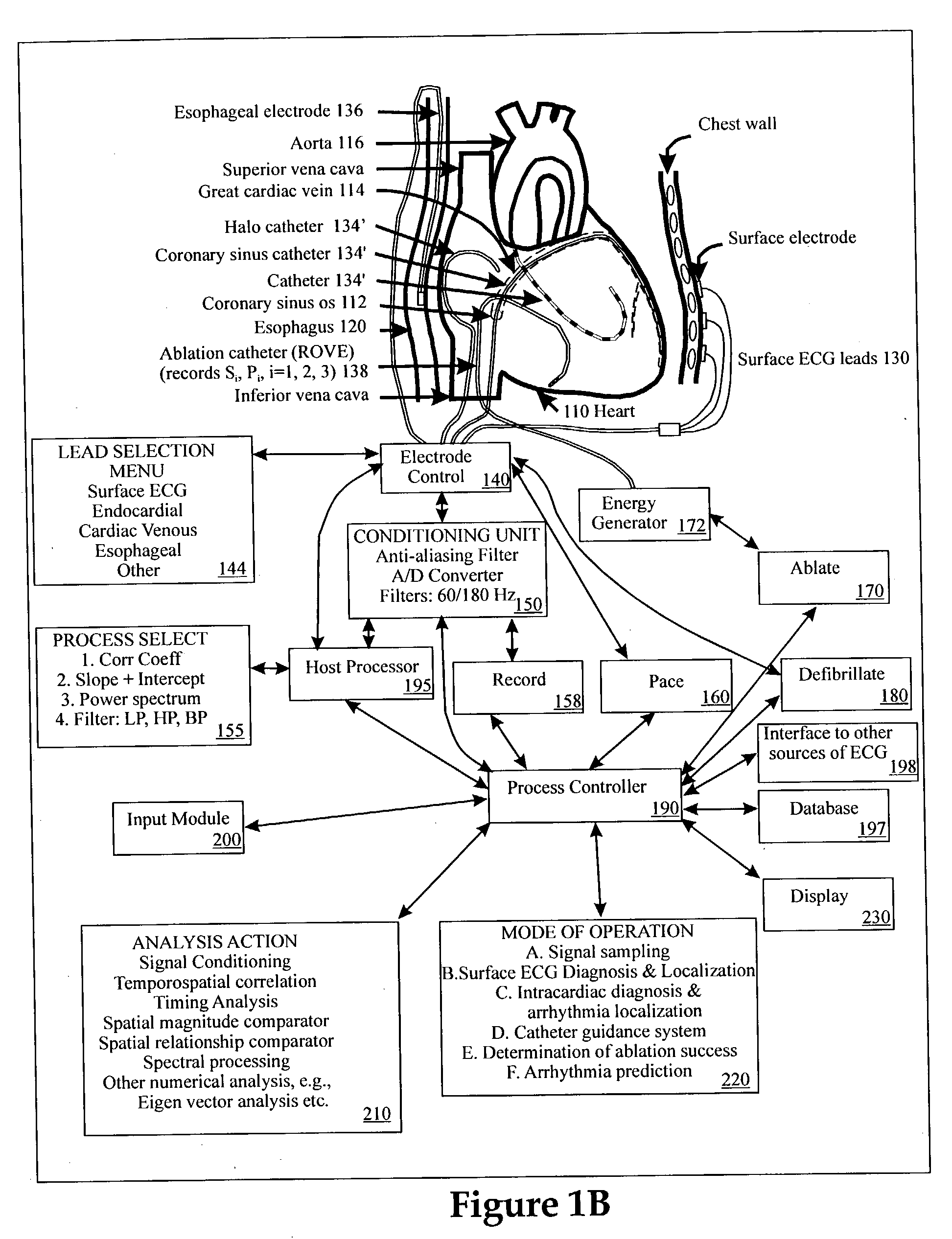However, these methods are limited when attempting to separate related rhythms, such as AF or AT from AFL as shown by Horvath et al.
However, these methods simply enhance atrial activity.
Such signals are obtained at invasive electrophysiologic study, which introduces discomfort and potentially serious risks to the patient.
However, much of this work cannot separate typical from atypical AFL, which have similar rates and ECG appearances, but different treatments.
This shows the obvious difficulty for even the most skilled practitioners to compare differences between 10-15 waveforms from multiple
catheter sites using just visual analysis.
There are very few methods in the prior art to determine if an arrhythmia has been ablated successfully.
First, work by Hamdan et al.
However, these methods are cumbersome and not always accurate, and practitioners often use the inability to re-start an arrhythmia to indicate that it has been eliminated; as discussed, this may be inaccurate if arrhythmia induction is sporadic.
However, the prior methods for locating an arrhythmia (mentioned above) are lengthy and difficult to perform during permanent pacemaker or defibrillator lead implantation.
However, they can have limitations and are rarely used except for research.
Most prior art in the field of arrhythmias has limited scope.
Thus, methods exist that can use either the
surface ECG or intracardiac signals, but few that can use both.
Furthermore, there are several methods that can examine the timing, spectra, spatial pattern or shape of ECG or intracardiac signals, but few that incorporate all four.
This lack of integration has arisen since methods focus on the manifestations of arrhythmia substrates, rather than on the substrates themselves.
This has slowed technical advances in arrhythmia management, since ECG diagnosis, arrhythmia localization and catheter guidance have had to be separated.
First, the prior art does not help very much in separate rhythms of similar rate and regularity from the ECG.
Ablation of typical AFL in these cases is less successful.
Second, the prior art has limited methods for analyzing superimposed activity.
The method of QRS subtraction is frequently applied to `uncover` P-wave activity, yet it introduces errors since the average QRS used for subtraction will differ from the actual QRS complex.
Third, the prior art is poor at localizing an arrhythmia site from the
surface ECG.
For example, they cannot determine if an atypical AFL circuit is in the right or left atria, which require significantly different invasive approaches.
Fourth, the prior art does not fully
exploit functional information, such as whether atrioventricular relationships are likely physiologic.
Thus, although methods have recently begun to focus on atrial versus
ventricular rate, they usually ignore additional information used by experts, such as the precise timing of ventricular to atrial activity (for example, in
atrial flutter with 4:1
ventricular conduction, does ventricular activity arise at the same point in each preceding atrial activity?)
Ablation therefore remains time-consuming and laborious, even for the most skilled practitioners of the art.
From the ECG, the prior art for localization is limited.
However, problems still arise when ECG patterns are not typical, such as atypical AFL masquerading as typical [1], or when another
rhythm event mimics these ECG patterns.
Ventricular arrhythmias are somewhat better localized from the ECG, but methods are still limited.
Second, vector analysis of ventricular complexes localizes the arrhythmia more easily than for
atrial arrhythmias, where low voltages obfuscate this analysis.
However, precise localization remains difficult and there are few tools enabling this task to be automated in modern ECG machines or laboratory
electrophysiology systems.
There is little prior art to aid or automate this cognitive process.
However, these methods are limited.
First, many different paced beats may produce the same numerical correlation against template, and therefore be indistinguishable.
Prior methods do not identify which of these pacing sites is most likely to lead to successful
ablation.
Third, the prior art usually analyzes very few paced beats (often one), as discussed by Saba [26], which may be subject to "impurities".
By way of another example, the beats analyzed may not adequately represent normal beat-to-beat variability, leading to the mis-classification of beats.
Fifth, the prior art correlation methods are greatly affected by amplitude or temporal scaling.
In other words, paced and native beats of the same shape, but differing either in magnitude or "stretched" relative to the other, will not match well.
As a corollary, the prior art is not effective when comparing rhythms of different rates, from different recording sessions or from different equipment.
Sixth, the prior art provides little aid in guiding a catheter from its current position to move closer to the putative ablation site.
However, the application of this method requires improvement.
This highlights the difficulties for a
human operator to compare subtle changes in the relative timing and shape of 12
surface ECG and additional intracardiac signals for each of several catheter positions, then select the set that matches the above criteria.
However, this method was not described for continuous
tachycardia.
In addition, it did not analyze the surface ECG, nor did it assess the other criteria of concealed entrainment.
The current rules for these methods make them unwieldy to apply while placing a poorly steerable lead.
There are few prior art methods to measure the effectiveness of ablation in eradicating the substrate for an arrhythmia.
Although markers of success exist for certain arrhythmias, such as P-
wave shape change and double potentials along the ablation line in AFL, most of the prior art does not probe the arrhythmia circuit and cannot therefore detect its absence after ablation.
Risk stratification for arrhythmias from the surface ECG is an attractive but largely elusive task.
Predicting the risk for AF remains difficult.
However, the "
heart rate variability" method of Kleiger et al.
[21] requires a long recording period, assesses only long-term risk, and cannot be performed in many patients with pre-existing arrhythmias such as AF.
Late potentials cannot be examined if patients have AF or bundle
branch block, and their predictive accuracy for VT or VF has also been seriously questioned.
The "T-wave alternans" method of Cohen in U.S. Pat. No. 4,802,481 has sub optimal predictive accuracy and requires considerable experience in interpretation, yet still often produces uninterpretable results (see, for example, Bloomfield et al.
[29]) and also cannot be performed if the patient has AF or bundle-
branch block.
None have entered routine clinical practice as none improve upon assessments of the strength of
ventricular contraction and other non-arrhythmic factors.
If a filter is used to reduce the
noise, the same filters must be employed for all subsequent analysis since filtering may alter electrogram morphology.
 Login to View More
Login to View More  Login to View More
Login to View More 


